Plum
A plum is a fruit of the subgenus Prunus of the genus Prunus. The subgenus is distinguished from other subgenera (peaches, cherries, bird cherries, etc.) in the shoots having terminal bud and solitary side buds (not clustered), the flowers in groups of one to five together on short stems, and the fruit having a groove running down one side and a smooth stone (or pit).
| Plum | |
|---|---|
 | |
| A plum; whole and split | |
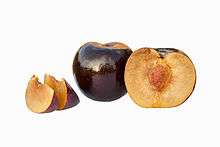 | |
| Black Amber plum | |
| Scientific classification | |
| Kingdom: | Plantae |
| Clade: | Tracheophytes |
| Clade: | Angiosperms |
| Clade: | Eudicots |
| Clade: | Rosids |
| Order: | Rosales |
| Family: | Rosaceae |
| Genus: | Prunus |
| Subgenus: | Prunus subg. Prunus |
| Species | |
|
See text | |
Mature plum fruit may have a dusty-white waxy coating that gives them a glaucous appearance. This is an epicuticular wax coating and is known as "wax bloom". Dried plum fruits are called "dried plums" or prunes, although, in many countries, prunes are a distinct type of dried plum having a wrinkled appearance (Li hing mui for instance).[1]
History
Plums may have been one of the first fruits domesticated by humans.[2] Three of the most abundant cultivars are not found in the wild, only around human settlements: Prunus domestica has been traced to East European and Caucasian mountains, while Prunus salicina and Prunus simonii originated in Asia. Plum remains have been found in Neolithic age archaeological sites along with olives, grapes and figs.[3][4] According to Ken Albala, plums originated in Iran.[5]
Etymology and names
The name plum derived from Old English plume or "plum, plum tree," which extended from Germanic language or Middle Dutch, and Latin prūnum, from Ancient Greek προῦμνον (proumnon), believed to be a loanword from Asia Minor.[1][6] In the late 18th century, the word, plum, was used to indicate "something desirable", probably in reference to tasty fruit pieces in desserts.[6]
Description
Plums are a diverse group of species. The commercially important plum trees are medium-sized, usually pruned to 5–6 metres (16–20 ft) height. The tree is of medium hardiness.[7] Without pruning, the trees can reach 12 metres in height and spread across 10 metres. They blossom in different months in different parts of the world; for example, in about January in Taiwan and early April in the United Kingdom.[8]
Fruits are usually of medium size, between 2–7 centimetres (0.79–2.76 in) in diameter, globose to oval. The flesh is firm and juicy. The fruit's peel is smooth, with a natural waxy surface that adheres to the flesh. The plum is a drupe, meaning its fleshy fruit surrounds a single hard seed.

Cultivation and uses
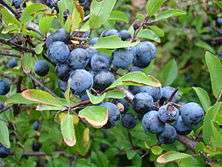
Plum cultivars include:
- Damson (purple or black skin, green flesh, clingstone, astringent)
- Greengage (firm, green flesh and skin even when ripe)
- Mirabelle (dark yellow, predominantly grown in northeast France)
- Satsuma plum (firm red flesh with a red skin)
- Victoria (yellow flesh with a red or mottled skin)
- Yellowgage or golden plum (similar to greengage, but yellow)
- Different plum cultivars
- Damsons
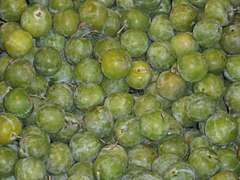 Greengages
Greengages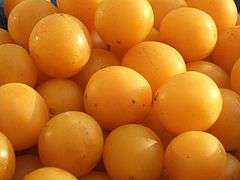 Mirabelles
Mirabelles Victoria plums
Victoria plums
When it flowers in the early spring, a plum tree will be covered in blossoms, and in a good year approximately 50% of the flowers will be pollinated and become plums. Flowering starts after 80 growing degree days.
If the weather is too dry, the plums will not develop past a certain stage, but will fall from the tree while still tiny, green buds, and if it is unseasonably wet or if the plums are not harvested as soon as they are ripe, the fruit may develop a fungal condition called brown rot. Brown rot is not toxic, and some affected areas can be cut out of the fruit, but unless the rot is caught immediately, the fruit will no longer be edible. Plum is used as a food plant by the larvae of some Lepidoptera, including November moth, willow beauty and short-cloaked moth.
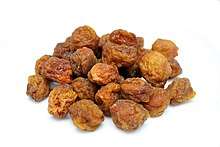
The taste of the plum fruit ranges from sweet to tart; the skin itself may be particularly tart. It is juicy and can be eaten fresh or used in jam-making or other recipes. Plum juice can be fermented into plum wine. In central England, a cider-like alcoholic beverage known as plum jerkum is made from plums. Dried, salted plums are used as a snack, sometimes known as saladito or salao. Various flavors of dried plum are available at Chinese grocers and specialty stores worldwide. They tend to be much drier than the standard prune. Cream, ginseng, spicy, and salty are among the common varieties. Licorice is generally used to intensify the flavor of these plums and is used to make salty plum drinks and toppings for shaved ice or baobing. Pickled plums are another type of preserve available in Asia and international specialty stores. The Japanese variety, called umeboshi, is often used for rice balls, called onigiri or omusubi. The ume, from which umeboshi are made, is more closely related, however, to the apricot than to the plum. In the Balkans, plum is converted into an alcoholic drink named slivovitz (plum brandy) (Serbian: šljivovica).[9][10] A large number of plums, of the Damson variety, are also grown in Hungary, where they are called szilva and are used to make lekvar (a plum paste jam), palinka (traditional fruit brandy), plum dumplings, and other foods. In Romania, 80% of the plum production is used to create a similar brandy, called țuică.[11]
As with many other members of the rose family, plum kernels contain cyanogenic glycosides, including amygdalin.[12] Prune kernel oil is made from the fleshy inner part of the pit of the plum. Though not available commercially, the wood of plum trees is used by hobbyists and other private woodworkers for musical instruments, knife handles, inlays, and similar small projects.[13]
| Country | Production | |
|---|---|---|
| 6,663,165 | ||
| 1,486,082 | ||
| 512,975 | ||
| 463,115 | ||
| 392,537 | ||
| 297,589 | ||
| 269,113 | ||
| 261,903 | ||
| 222,020 | ||
| 220,729 | ||
| World | 12,050,800 | |
| Source: UN Food & Agriculture Organization[14] | ||
Species
Plums have many species, and taxonomists differ on the count. Depending on the taxonomist, between 19 and 40 species of plum exist. From this diversity only two species, the hexaploid European plum (Prunus domestica) and the diploid Japanese plum (Prunus salicina and hybrids), are of worldwide commercial significance. The origin of these commercially important species is uncertain but may have involved P. cerasifera and possibly P. spinosa as ancestors. Other species of plum variously originated in Europe, Asia and America.[15]
| Nutritional value per 100 g (3.5 oz) | |
|---|---|
| Energy | 192 kJ (46 kcal) |
11.42 g | |
| Sugars | 9.92 g |
| Dietary fiber | 1.4 g |
0.28 g | |
0.7 g | |
| Vitamins | Quantity %DV† |
| Vitamin A equiv. | 2% 17 μg2% 190 μg73 μg |
| Thiamine (B1) | 2% 0.028 mg |
| Riboflavin (B2) | 2% 0.026 mg |
| Niacin (B3) | 3% 0.417 mg |
| Pantothenic acid (B5) | 3% 0.135 mg |
| Vitamin B6 | 2% 0.029 mg |
| Folate (B9) | 1% 5 μg |
| Vitamin C | 11% 9.5 mg |
| Vitamin E | 2% 0.26 mg |
| Vitamin K | 6% 6.4 μg |
| Minerals | Quantity %DV† |
| Calcium | 1% 6 mg |
| Iron | 1% 0.17 mg |
| Magnesium | 2% 7 mg |
| Manganese | 2% 0.052 mg |
| Phosphorus | 2% 16 mg |
| Potassium | 3% 157 mg |
| Sodium | 0% 0 mg |
| Zinc | 1% 0.1 mg |
| Other constituents | Quantity |
| Water | 87 g |
| |
| †Percentages are roughly approximated using US recommendations for adults. Source: USDA Nutrient Database | |
The subgenus Prunus is divided into three sections:
Sect. Prunus (Old World plums) – leaves in bud rolled inwards; flowers 1-3 together; fruit smooth, often wax-bloomed
| Image | Scientific name | Common Name | Distribution | Cytology |
|---|---|---|---|---|
 | P. cerasifera | cherry plum, myrobalan plum | Southeast Europe and Western Asia | 2n=16,(24) |
| P. cocomilia | Italian plum | Albania, Croatia, Greece, southern Italy (including Sicily), Montenegro, North Macedonia, Serbia, and western Turkey | ||
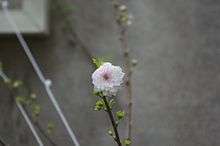 | P. japonica | Japanese bush cherry | Central China through to the Korean peninsula | |
 | P. domestica (species of most "plums" and "prunes") | Europe | 2n=16, 48 | |
 | P. domestica ssp. insititia | damsons, bullaces | Asia | |
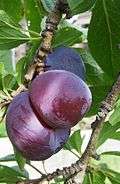 | P. salicina | Chinese plum | China | 2n=16,(24) |
| P. simonii (widely cultivated in North China)[16] | China | 2n=16 | ||
 | P. spinosa | blackthorn or sloe | Europe, western Asia, and locally in northwest Africa | 2n=4x=32 |
.jpg) | P. vachuschtii | Alucha | Caucasus |
Sect. Prunocerasus (New World plums) – leaves in bud folded inwards; flowers 3–5 together; fruit smooth, often wax-bloomed
| Image | Scientific name | Common Name | Distribution | Cytology |
|---|---|---|---|---|
| P. alleghaniensis | Allegheny plum | the Appalachian Mountains from New York to Kentucky and North Carolina, plus the Lower Peninsula of Michigan | ||
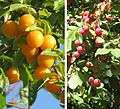 | P. americana | American plum | North America from Saskatchewan and Idaho south to New Mexico and east to Québec, Maine and Florida | |
| P. angustifolia | Chickasaw plum | Florida west as far as New Mexico and California | ||
| P. gracilis | Oklahoma plum | Alabama, Arkansas, Colorado, Kansas, Louisiana, New Mexico, Oklahoma and Texas | ||
| P. havardii | Havard's plum | western Texas in the United States and to northern Chihuahua across the Río Grande in Mexico | ||
 | P. hortulana | Hortulan plum | Arkansas, Iowa, Illinois, Indiana, Kansas, Kentucky, Massachusetts, Maryland, Missouri, Nebraska, Ohio, Oklahoma, Tennessee, Texas, Virginia, West Virginia | |
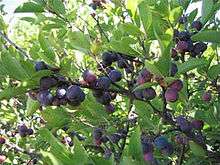 | P. maritima | Beach plum | East Coast of the United States, from Maine south to Maryland | |
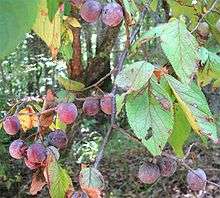 | P. mexicana | Mexican plum | central United States and Northern Mexico | |
| P. murrayana | Murray's plum | Texas | ||
 | P. nigra | Canada plum, Black plum | eastern North America from Nova Scotia west to Minnesota and southeastern Manitoba, and south as far as Connecticut, Illinois, and Iowa | |
| P. × orthosepala (P. americana × P. angustifolia) | southern and central United States | |||
 | P. reverchonii | Thicket plum | ||
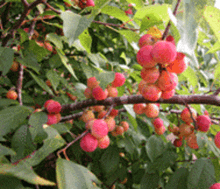 | P. rivularis | River plum, Creek plum,Wildgoose plum | California, Arkansas, southern Illinois, south-eastern Kansas, Kentucky, northern Louisiana, Mississippi, Missouri, south-western Ohio, Oklahoma, Tennessee, and Texas | |
 | P. subcordata | Klamath, Oregon, or Sierra plum | California and western and southern Oregon | |
| P. texana | Texas plum, Sand plum, Peachbush plum | central and western Texas | ||
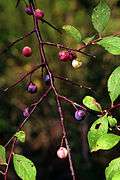 | P. umbellata | Hog plum, Flatwoods plum, Sloe plum | United States from Virginia, south to Florida, and west to Texas | |
Sect. Armeniaca (apricots) – leaves in bud rolled inwards; flowers very short-stalked; fruit velvety; treated as a distinct subgenus by some authors
| Image | Scientific name | Common Name | Distribution | Cytology |
|---|---|---|---|---|
 | P. armeniaca | apricot | Asia | 2n=16 |
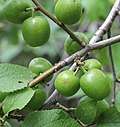 | P. brigantina | Briançon apricot, marmot plum | Europe | |
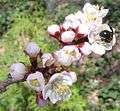 | P. mandshurica | Manchurian apricot and Scout apricot | northeast China, Korea, and Manchuria | |
 | P. mume | Chinese plum, Japanese apricot | Western Asia | |
 | P. sibirica | Siberian apricot | eastern China, Japan, Korea, Mongolia, and eastern Siberia. | |
In certain parts of the world, some fruits are called plums and are quite different from fruits known as plums in Europe or the Americas. For example, marian plums are popular in Thailand, Malaysia and Indonesia, otherwise also known as gandaria, plum mango, ma-praang, ma-yong, ramania, kundang, rembunia or setar.[17] Another example is the loquat, also known as Japanese plum and Japanese medlar, as well as nispero, bibassier and wollmispel elsewhere.[18][19] In South Asia and Southeast Asia, Jambul, a fruit from tropical tree in family Myrtaceae, is similarly sometimes referred to 'damson plums', and it is different from damson plums found in Europe and Americas.[20] Jambul is also called as Java plum, Malabar plum, Jaman, Jamun, Jamblang, Jiwat, Salam, Duhat, Koeli, Jambuláo or Koriang.
Production
In 2016, global production of plums and sloes was 12.1 million tonnes, led by China with 55% of the world total (table).[14] Other major producers were Romania, Serbia, and the United States (table).
Nutrition
Raw plums are 87% water, 11% carbohydrates, 1% protein, and less than 1% fat (table). In a 100-gram (3 1⁄2-ounce) reference serving, raw plums supply 192 kilojoules (46 kilocalories) of food energy and are a moderate source only of vitamin C (12% Daily Value), with no other nutrients in significant content (table).
See also
References
- "Prune". Oxford Dictionaries, Oxford University Press. 2018. Retrieved 1 March 2018.
- Jules Janick, ed. (1998). Horticultural Reviews (Volume 23). Wiley. ISBN 978-0471254454.
- Jules Janick (2005). "The origins of fruits, fruit growing and fruit breeding" (PDF). Purdue University. Archived (PDF) from the original on 2013-05-21.
- Spangenberg; et al. (January 2006). "Chemical analyses of organic residues in archaeological pottery from Arbon Bleiche". Journal of Archaeological Science. 33 (1): 1–13. doi:10.1016/j.jas.2005.05.013.
- Albala, Ken (2011). Food Cultures of the World Encyclopedia. ABC-CLIO. p. 240. ISBN 978-0-313-37626-9.
- "Plum". Etymology Online Dictionary; Douglas Harper. 2017. Archived from the original on 2 July 2017. Retrieved 12 June 2017.
- "Plum, prune, European type". Purdue University. 1999. Archived from the original on 2012-04-12.
- "Prunus domestica Plum, European plum PFAF Plant Database". pfaf.org. Archived from the original on 2012-11-22.
- Crowell and Guymon (1973). "Aroma Constituents of Plum Brandy". American Journal of Enology. 24 (4): 159–165.
- Jan Velíšek; František Pudil; Jiří Davídek; Vladislav Kubelka (1982). "The neutral volatile components of Czechoslovak plum brandy". Zeitschrift für Lebensmittel-Untersuchung und -Forschung A. 174 (6): 463–466. doi:10.1007/BF01042726.
- România e cel mai mare producător de prune din UE. Cele mai multe fructe folosesc la ţuică și palincă
- Burrows, G.E.; Tyrl, R.J. (2012). "Rosaceae Juss.". Toxic Plants of North America. Wiley-Blackwell. pp. 1064–1094.
- "Plum". The Wood Database. Archived from the original on 2014-10-25.
- "Plum (and sloe) production in 2016; Crops/Regions/World/Production Quantity by picklists". UN Food & Agriculture Organization, Statistics Division. 2018. Retrieved 1 March 2018.
- Bruce L. Topp; Dougal M. Russell; Michael Neumüller; Marco A. Dalbó; Weisheng Liu (2012). Plum (Handbook of Plant Breeding). 8, part 3. pp. 571–621. doi:10.1007/978-1-4419-0763-9_15.
- "Prunus simonii in Flora of China @ efloras.org". efloras.org. Archived from the original on 2013-11-03.
- "Under-Utilized Tropical Fruits of Thailand (see Part 1, section 3)". FAO, United Nations. 2001. Archived from the original on 2011-07-15.
- "Japanese Plum - Loquat". University of Florida, Nassau County Extension, Horticulture. 2006. Archived from the original on 23 July 2008.
- J. Morton (1987). "Loquat". University of Purdue. Archived from the original on 2013-06-24.
- "Jambolan". Purdue University. 2006. Archived from the original on 2012-09-10.
External links
| Wikimedia Commons has media related to Plums. |
| Look up plum in Wiktionary, the free dictionary. |
- Prunus americanum images hosted by the Department of Biological Sciences of Vanderbilt University
- Plum orchards information – Ministry of Agriculture, British Columbia, Canada